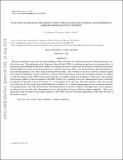Evolution of the transverse density structure of oscillating coronal loops inferred by forward modelling of EUV intensity
Abstract
Recent developments in the observation and modelling of kink oscillations of coronal loops have led to heightened interest over the last few years. The modification of the Transverse Density Profile (TDP) of oscillating coronal loops by non-linear effects, in particular the Kelvin-Helmholtz Instability (KHI), is investigated. How this evolution may be detected is established, in particular, when the KHI vortices may not be observed directly. A model for the loop's TDP is used which includes a finite inhomogeneous layer and homogeneous core, with a linear transition between them. The evolution of the loop's transverse intensity profile from numerical simulations of kink oscillations is analysed. Bayesian inference and forward modelling techniques are applied to infer the evolution of the TDP from the intensity profiles, in a manner which may be applied to observations. The strongest observational evidence for the development of the KHI is found to be a widening of the loop's inhomogeneous layer, which may be inferred for sufficiently well resolved loops, i.e > 15 data points across the loop. The main signatures when observing the core of the loop (for this specific loop model) during the oscillation are: a widening inhomogeneous layer, decreasing intensity, an unchanged radius, and visible fine transverse structuring when the resolution is sufficient. The appearance of these signatures are delayed for loops with wider inhomogeneous layers, and quicker for loops oscillating at higher amplitudes. These cases should also result in stronger observational signatures, with visible transverse structuring appearing for wide loops observed at SDO/AIA resolution.
Citation
Goddard , C R , Antolin , P & Pascoe , D J 2018 , ' Evolution of the transverse density structure of oscillating coronal loops inferred by forward modelling of EUV intensity ' , Astrophysical Journal , vol. 863 , 167 . https://doi.org/10.3847/1538-4357/aad3cc
Publication
Astrophysical Journal
Status
Peer reviewed
ISSN
0004-637XType
Journal article
Description
This work was supported by the European Research Council (ERC) under the SeismoSun Research Project No. 321141 (CRG, DJP) and by the British Council via the Institutional Links Programme (Project 277352569 - Seismology of Solar Coronal Active Regions) (CRG). DJP has received funding from the ERC under the European Union’s Horizon 2020 research and innovation programme (grant agreement No 724326). P.A. has received funding from the UK Science and Technology Facilities Council (Consolidated Grant ST/K000950/1), the European Union Horizon 2020 research and innovation programme (grant agreement No. 647214) and his STFC Ernest Rutherford Fellowship (grant agreement No. ST/R004285/1).Collections
Items in the St Andrews Research Repository are protected by copyright, with all rights reserved, unless otherwise indicated.

